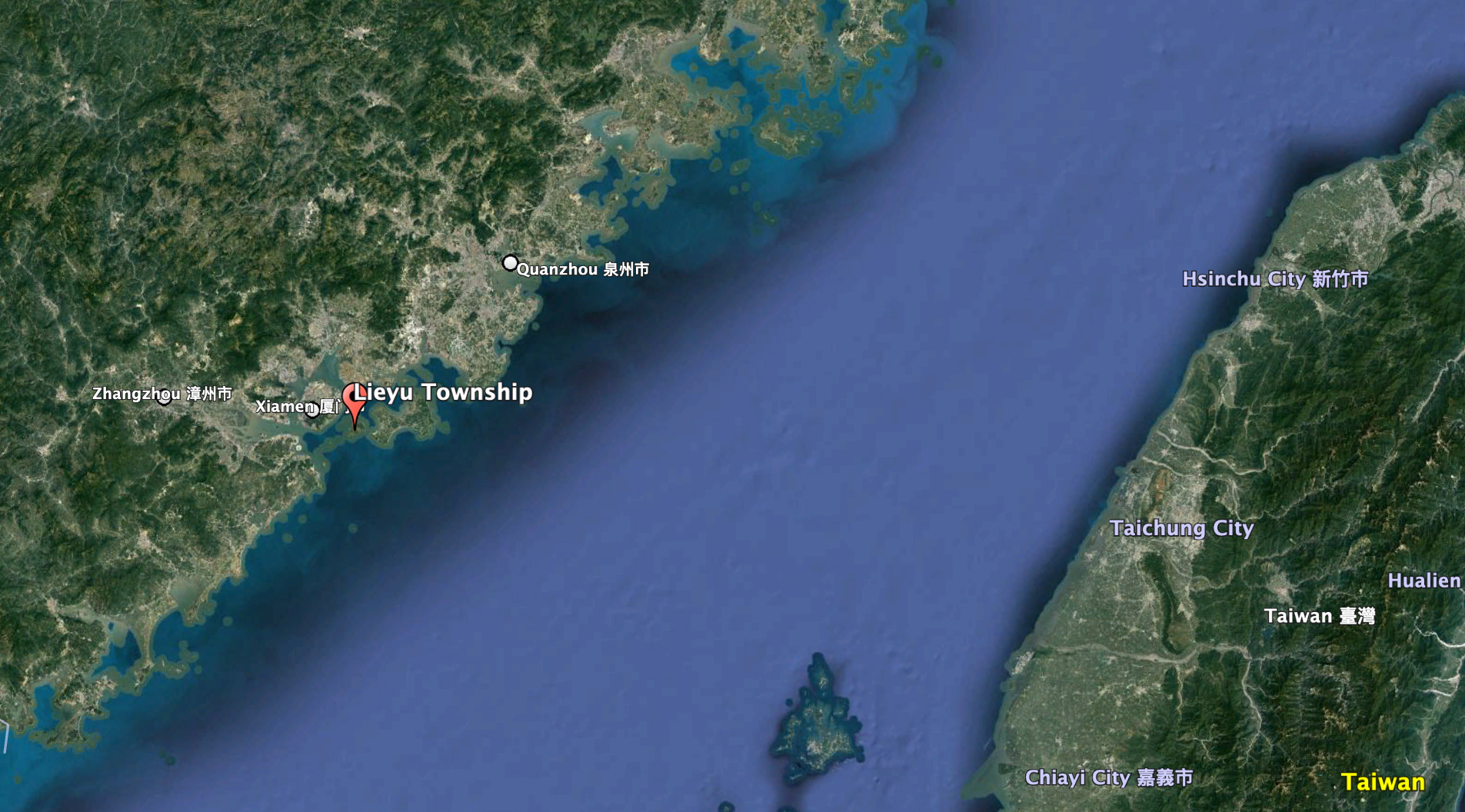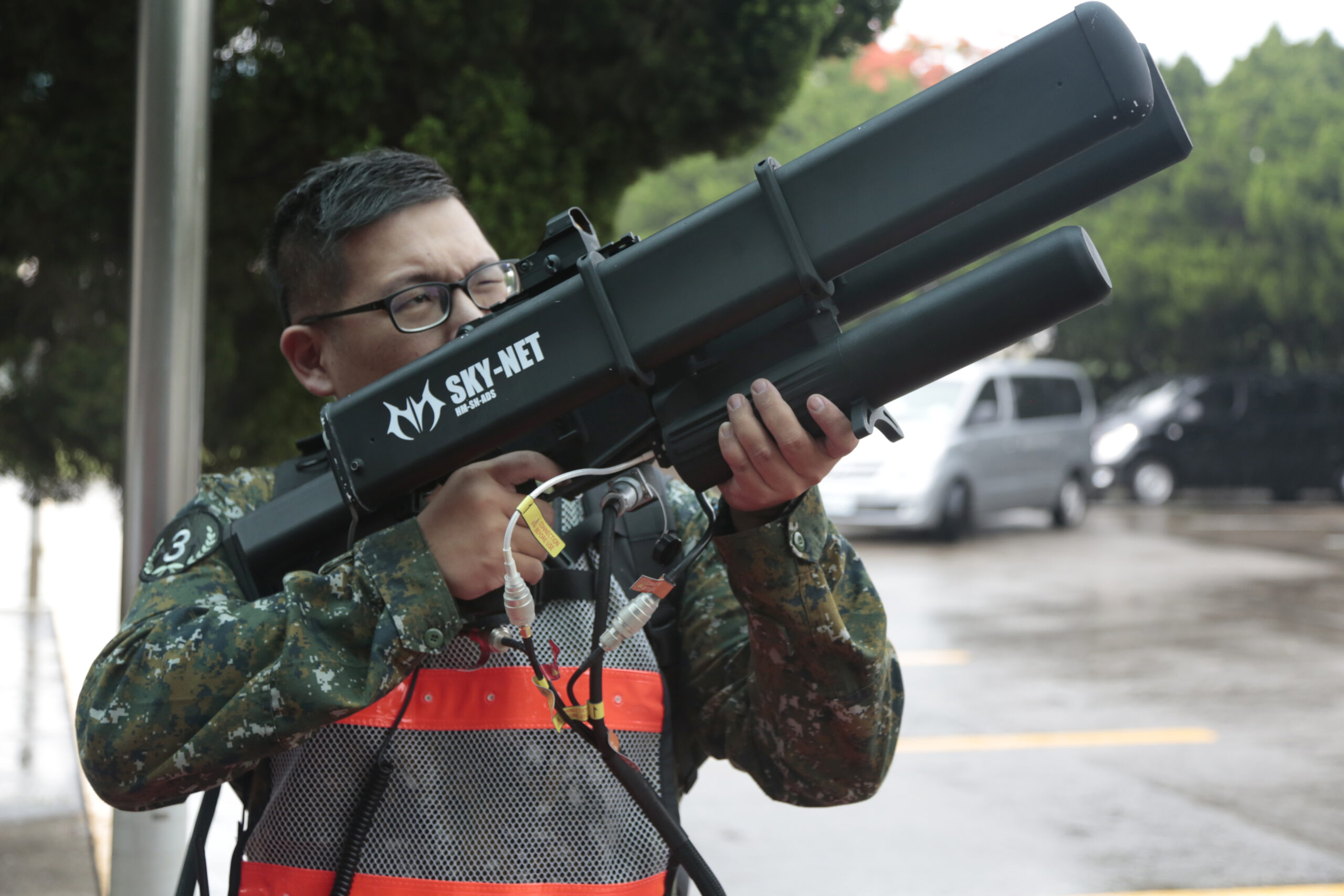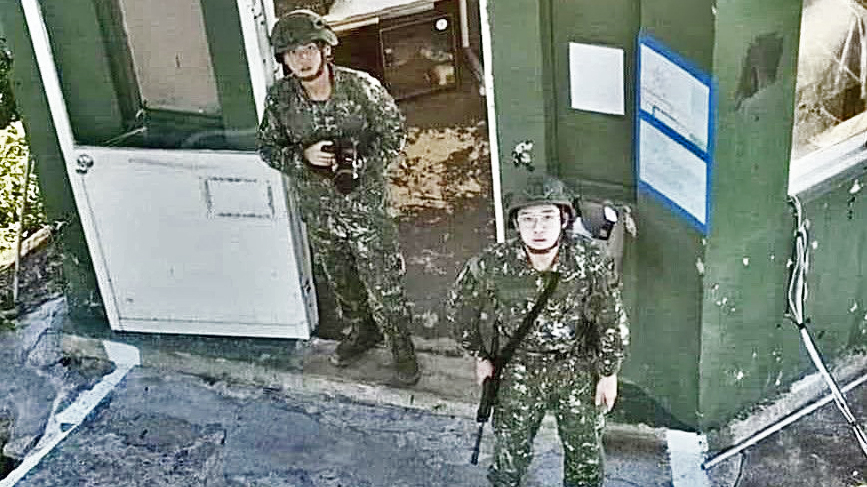Two bewildered-looking soldiers gaze up, as a drone appears over their position, seemingly unexpectedly. The drone is clearly watching them, watching it, and it could potentially be carrying weapons, too. Moments later, the troops appear to hurl rocks at the drone in an effort to knock it out of the sky. This is a drone’s eye view of one aspect of the ongoing tensions in the Taiwan Strait and a startling reminder of what’s a fairly new facet of warfare and one that’s proven generally difficult to effectively counter.
The photo in question, a cropped version of which is seen at the top of this story, dates from around 6:00 pm on August 16, when the mysterious drone appeared over the Lieyu Garrison Battalion on one of the islands of Kinmen, also known as Quemoy. These islands are governed by Taiwan but are located off the southeastern coast of mainland China. Clearly, the drone was equipped with some kind of optical surveillance equipment and its operator was taking a very keen interest in the military installation in these long-disputed islands.

The image of the two Republic of China Army, or ROCA, sentries, one holding a camera, the other with an assault rifle at his side, soon began to circulate on Chinese social media. Now, Taiwan’s Ministry of National Defense has confirmed that it is authentic.
There is also a video that appears to show the exact same military facility, with two soldiers now seen throwing rocks or other objects at the drone, once again from the unmanned aerial vehicle’s perspective. It suggests that the soldiers at the garrison employed very unsophisticated means in an effort to either bring the drone down or ward it off.

But there are differing views as to the operator of the drone in question and the measures taken in response by the soldiers at the garrison.
Citing an unnamed spokesman from the Kinmen Defense Command, Taiwan News reports that the drone was civilian-operated. The same spokesman added that it was flying over waters off the coast of Lieyu Township, at a height of around 3,300 feet, but did not enter its airspace. Based on the video footage, the claim that the drone didn’t enter the local airspace seems highly questionable, at best.
The same report says that the drone was issued a radio warning and that it “quickly flew away.” Exactly how a radio warning was issued is unclear, but, overall, this scenario seems improbable, considering the types of drones that are commercially available. While larger drones may have onboard UHF/VHF radios used to transmit and receive voice communications between the drone controller and air traffic control, this is not the case for smaller UAVs that don’t normally share airspace with other aircraft.
Interestingly, the spokesman identified the military installation in Lieyu as a monitoring station “specifically positioned to monitor PLA aircraft flying in the area,” according to Taiwan News, and that the marauding drone had not gathered potentially sensitive intelligence since it did not constitute a “major military base.”
However, according to Tingting Liu, a foreign affairs and military correspondent for the Taiwan-based TVBS News, the Ministry of National Defense said that the photo “was taken by long lens from a PLA [Chinese People’s Liberation Army] drone flying over Kinmen.”
The ministry “stressed that the soldiers intercepted the drone immediately,” the same account continues. The correspondent suggests that “interception refers to the ministry driving the drone away through signals and probably flares.” While signal flares have been used in response to other recent drone incursions, that doesn’t seem to have been the case here.
Neither account mentions that rocks were thrown.
The official lines apparently provided by members of Taiwan’s Ministry of National Defense that form the basis of both these accounts also raise questions. While the ministry’s statements stress that the drone was at some distance from the base, hence the reference to a “long lens,” or it being outside of local airspace, the available imagery suggests it was much closer. After all, it was clearly close enough for soldiers to throw rocks at.
As to the operator of the drone, there’s also the possibility of some kind of civilian drone flying on behalf of the Chinese military or intelligence agencies, which would be in keeping with Beijing’s increasing use of ‘gray zone tactics’ – pushing the limits of normal peacetime operations toward the threshold of armed conflict, often using unconventional and non-military means.
However, other PLA drones have been reported in the vicinity of Taiwanese infrastructure around the Taiwan Strait in recent weeks, as relations between Taiwan and the mainland become increasingly strained. The recent low came in the wake of the controversial visit to Taiwan by U.S. Speaker of the House Nancy Pelosi, at the beginning of the month. This was also followed by a round a week of live-fire exercises as well as significant activity by PLA aircraft and warships in the Taiwan Strait, much of which continues.
A tweet from Taiwan’s Ministry of National Defense records the latest PLA aircraft and warships identified in the Taiwan Strait, for August 24:
On August 3, a day after Pelosi’s arrival in Taiwan, local news sources reported that Taiwan troops had “fired flares” at two PLA-operated drones. These were reportedly flying within Kinmen County airspace in what was said to be the first time that PLA drones had appeared there.
The following day, the ROCA’s Kinmen Defense Command announced that unidentified aircraft had been noted flying over the Kinmen Islands and the nearby Beiding Island at an altitude of around 6,500 feet, and later determined that they were two UAVs. Military officials said these drones flew together into Kinmen’s airspace twice in the same evening, at around 9:00 pm and 10:00 pm.
“We immediately fired flares to issue warnings and to drive them away,” said Maj. Gen. Chang Zone-sung of the Kinmen Defense Command. “After that, they turned around. They came into our restricted area and that’s why we dispersed them,” he added.
In the wake of that earlier incident, Taiwan’s Ministry of National Defense stated that firing flares was “in accordance with standard operating procedures” and was intended to warn the drones to leave Taiwan’s airspace.
Indeed, a similar response had come on July 28, when a reported Chinese drone flew close to the island of Dongyin, part of the Matsu Islands, alongside the southeastern coast of mainland China, with flares again being fired. On that occasion, the PLA drone was suspected to be a CSC-005, a type with vertical takeoff and landing (VTOL) capability. This incident occurred during the PLA’s Han Guang exercise but before they announced the large-scale maneuvers off Taiwan.
Interestingly, the ministry also noted at the time of the August 3 incident that efforts were underway to provide additional camouflage for military installations that might be surveilled by drones and that further “countermeasures” were being carried out to prevent reconnaissance by drones. Innovative measures to conceal military infrastructure and vehicles are something of a trademark of the Taiwanese military, although it’s not clear that any such attempts were made to hide the Lieyu Garrison Battalion.
Whatever the origin of the drone that appeared over the Lieyu Garrison Battalion, it’s clear that officials consider that UAVs, in general, are being used to gather intelligence on Taiwan’s defensive posture on its outlying islands.
This is also a threat that has ramped up significantly within the last few weeks. Roy Choo, the co-author of Modern Taiwanese Air Power, told The War Zone that, prior to the recent rounds of tensions, UAV overflights of Kinmen and Matsu islands were almost unheard of. He also noted that “All in all, 20 UAVs were encountered by Taiwan between August 3 and August 8,” suggesting that the PLA has normalized this kind of activity.
It is also telling that despite the clear proliferation of drones of all kinds within the PLA more generally, Taiwan’s response to them, at least in peacetime, seems to be worryingly deficient, at least based on this latest evidence. While Taiwan is known to operate portable anti-drone jammers, including the Sky Net system, not to mention various anti-aircraft systems that could feasibly take down drones, there is little evidence of any of these having been deployed in any of the recent incidents.

Perhaps the use of anti-drone jammers or kinetic means to down a PLA drone is judged too provocative, but that begs the question of how throwing rocks at a drone is different. Unless, of course, those sentries knew for certain that their target was a civilian-operated UAV, which seems unlikely.
The War Zone has on multiple occasions in the past looked at the threat posed by drones, including smaller, commercially available types.
In the Taiwan scenario, in particular, the U.S. has recently looked at the vital role that swarms of relatively low-cost networked drones with high degrees of autonomy, would likely play — for both sides — in a future confrontation between China and Taiwan.
A Chinese light tactical vehicle outfitted with an array of tubular launchers to deliver a swarm of loitering munitions:

When the U.S Air Force released details about a Taiwan-related wargame that was conducted in 2020, the service noted that this included the employment of a notional swarm of small drones, as well as other unmanned assets. While exercises like this, as well as modeling that RAND has done, look primarily at the advantages that large numbers of unmanned aircraft, especially relatively small and inexpensive ones, would bring to the U.S. military to defend against a Chinese invasion of Taiwan, it’s increasingly clear that China, too, would make considerable use of similar systems, to gather intelligence, fly strike sorties, serve as communication nodes, as well as cause maximum disruption to Taiwan’s air defense network. This is especially true when it comes to a large, resilient networked swarm that can be deployed over a vast area to shorten the ‘kill chain’ dramatically.
And while smaller drones, including weaponized ones, have proven their worth on the battlefield and in other scenarios in recent years, the relatively short distances involved in contingencies involving Taiwan, mean that small unmanned vehicles would also be able to play a major role.
A video showing a drone swarm test conducted by the China Electronics Technology Group Corporation, or CETC, in 2016:

Indeed, there is some evidence to suggest that the PLA is advancing in some of these areas faster than the United States in this area, with heavy investment in various advanced unmanned capabilities, including technology to enable networked swarms, and has also made impressive strides in fielding new platforms.
Even if the drone that was encountered by sentries at the Lieyu Garrison Battalion was not related to the PLA, it should at least serve as a warning about the kinds of threats that unmanned systems can present. After all, this was just one, apparently commercially available UAV. A large-scale confrontation around the Taiwan Strait would likely see the PLA make use of its own drone swarms, launched from the mainland or even from ships at sea.
It remains to be seen whether Taiwan’s military will, in the future, take a different approach to dealing with drones approaching its airspace, or even operating within it. Certainly, this is a threat that will only proliferate, especially as the concept of autonomous drone swarms moves closer to reality.
Contact the author: thomas@thedrive.com
